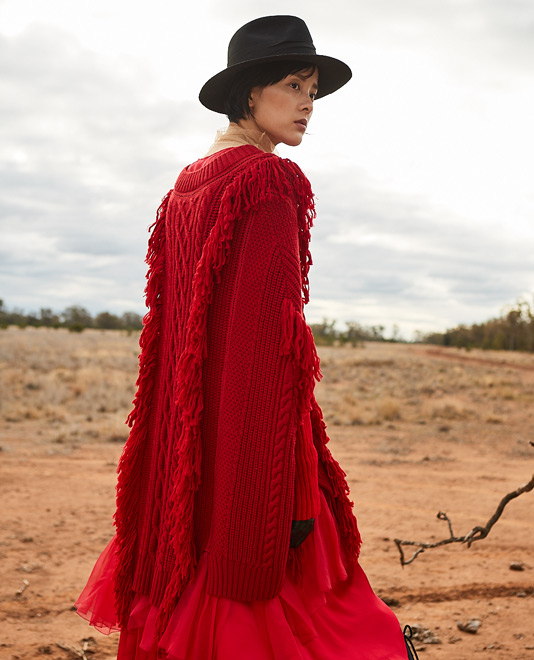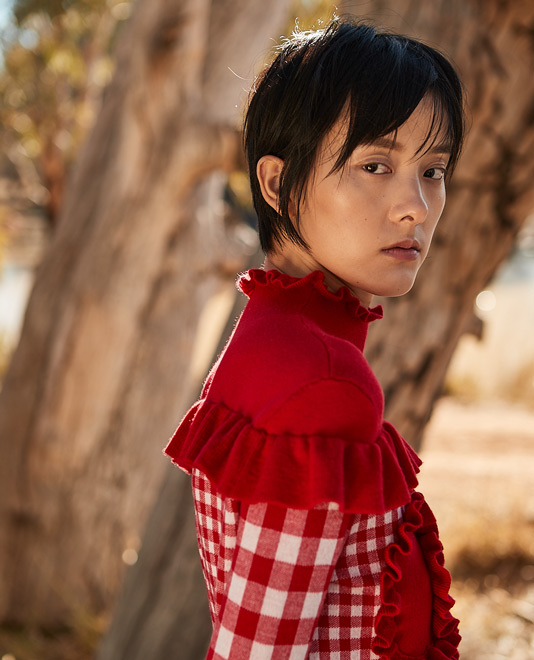Chinese designer and International Woolmark Prize alumnus BAN XIAOXUE continues to show his support to the Australian wool industry, releasing a traceable knitwear collection for Fall/Winter 2019.
Partnering with The Woolmark Company and working with leading spinner XINAO, the Merino wool used in this collection can be traced back to the farms in Australia where it was produced. The collection features 30 creative and innovative knits, in a mixture of 100% Merino wool and wool blends and includes dresses, skirts, blouses sweaters and vests.
With both traceability and supply chain transparency playing a vital role in fashion’s complex ecosystem, an increasing number of labels know the importance of building their business around this. The Woolmark Company works with designers to connect them with the supply chain, allowing designers to have strong working relationships with spinners, mills and manufacturers, just as BAN XIOXUE has with XINAO.
Inspired by roaming clouds, the English translation for this collection is wanderlust, marrying oriental romance with traditional eastern elements into knitwear and blending this with contemporary design.
Knitwear has always been a particularly important part of the BAN XIAOXUE brand, remaining at its core to this day. According to Ban, it’s the charm of knitwear and an element of the unknown which can bring innovation to the design.
“From my first autumn/winter collection to today, the ratio of knitwear present in my collections has increased year by year. From simple knitwear products we had to begin with, I have turned to a combination of shuttle knitting, knit accessories, and even adopted increasingly more sophisticated knitwear crafts and techniques. This plays an increasingly important value; it is irreplaceable for me.”
Knowing where the Merino wool comes from and selecting yarn from a single spinner allows for a great sense of supply chain transparency and a roadmap for the Wanderlust journey. It helps complete the full circle of design and shies away from the traditional linear model of fashion.
“The product itself doesn’t uniquely measure its value but the whole cycle of the product does; the sale of a piece of clothing is not the end of the cycle but the beginning of its mission. The origins of the product, the realisation of the design and the after sale are all integral parts in building the real story of a product.”


The collection is divided into three parts, which express the concept of wanderlust through capturing the process of a flower germinating, blooming and fading. Each part uses different methods and shapes to interpret a different state.
“The first part hides the brush ink under a clear material, which is a symbol of germination and growth, corresponding to the concept of ‘roaming’. The second part is a mosaic of complex three-dimensional flower decoration on the geometric jacquard, which means that the flowers bloom and compete to bloom, which corresponds to the concept of ‘fighting’. The third part adopts material splicing, meaning that it is withered or reborn, corresponding to the concept of ‘hiding’.
“Different forms and techniques have been used to interpret different states of wanderlust; for example, combining flowers with Chinese brush drawing ink techniques and the warmth of the knit to achieve a sense of flow,” explains Ban. “A three-dimensional pattern is used to form the shape of the flower scattered in the mottled geometric jacquard pattern creates interesting innovations in this collection.”